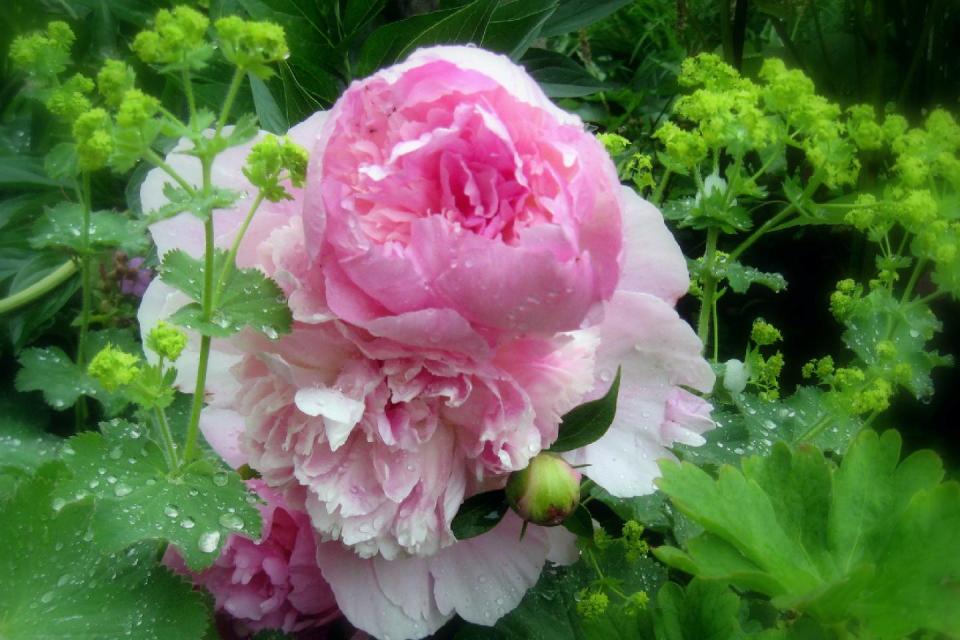Master Gardener: Peonies are the largest, showiest spring flowers

You can’t miss peonies that are blooming in May! This is the largest and showiest of spring flowers here in Ohio. It is a perennial which blooms every year.
Peonies have three different growing habits. Herbaceous peony (Paeonia lactiflora) is the most common. It dies back each fall and starts pushing forth new growth in the spring resulting in a bush that can be 3 to 4 feet tall. The stem typically produces one single flower.
The Tree Peony (Paeonia suffruticosa) and associated hybrids, is not actually a tree but rather is a deciduous shrub. It is a slow-growing plant with a single woody stem that can be 4 to 6 feet tall. Although leaves drop in the fall, do not cut the stem if you want to see blooms the next spring.
The third type of growth habit is the Intersectional Peony. It is a bush type but smaller than the herbaceous. Like the herbaceous, it dies back to the ground in the fall. This peony was developed by crossing the tree peony with the herbaceous peony and the result is also called the Itoh peony or Itoh hybrid. The outstanding characteristic of this peony’s bloom is that they come in a variety of colors not available in the herbaceous or tree peony.

The American Peony Society recognizes eight color classes: white or yellow, bluish, light pink, medium pink, dark pink, light red, medium red, and dark red.
Peonies have large outer petals which surround the pollen-bearing stamens. There are six peony flower forms which are dependent on the "transformation" of the stamens ranging from very apparent and visible to not existent.
"Double Form" has the most massive blooms of all the forms. Another showy form is called the "Bomb," which opens small and widens progressively as it matures. The stamens are not visible.
The Single, Japanese and Anemone have a single outer layer of petals, but the stamens in the center follow a transformation pattern and range from yellow to the same color as the outer petals.
The sixth flower form is the "Semi-Double" which has a significant number of outer petals, but fewer smaller inner petals. The center ring of yellow stamens is quite visible.
Cultivation
Gardeners should consider site selection before planting or dividing peonies. Well-drained soil in an area that gets at least six hours of full sun is most desirable.
Planting or dividing and replanting should be done in the fall so that the root system can become established before the upper growth occurs. Mulch only the first year and then remove excess soil in the spring.
Potted plants sold in garden centers and nurseries should have well-established roots and can be planted in the spring.
Encourage your peonies to grow and bloom by adding nitrogen fertilizer to the soil in the spring and partway through the growing season. Be sure to follow the instructions on the package.
As the peony continues to grow in the spring, it is a good idea to use garden fence to support the plant. Nothing is more disheartening than to see all the beautiful blooms and foliage flattened on the ground after a spring storm.
Insects and disease
Some people worry that their peonies are diseased because they see ants on the stems and the blooms. Entomologists explain the ants are sipping nectar and are not harming the peony at all.
When you cut the peony to bring inside for a vase of flowers, be sure to shake off the ants. The vase of peonies will be a beautiful addition to your table.
Although peonies are rarely bothered by disease or insects, the gardener must watch for scale and botrytis.
Scale can be seen on the stalks and leaf base in the summer. It overwinters on the ground portion of the stalks during the winter. Remove the plant material in the late fall and apply an appropriate insecticide in late May the following year.
Botrytis is a parasitic fungus in the soil. In the fall, cut down the plant and burn all the leaves and stems. Using Bordeaux mixtures spray from early spring until August. A top dressing of sand around the crown of the plant often helps to check the blight.
Christine Michael is a Master Gardener with the Sandusky/Ottawa County Extension Offices.
This article originally appeared on Fremont News-Messenger: Master Gardener: Peonies are the largest, showiest spring flowers

